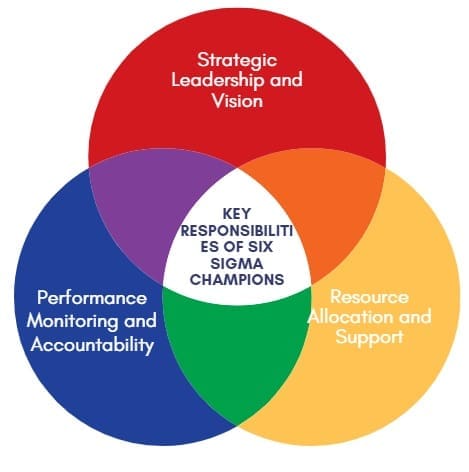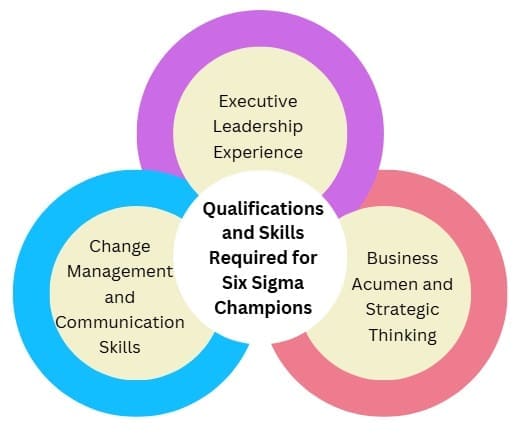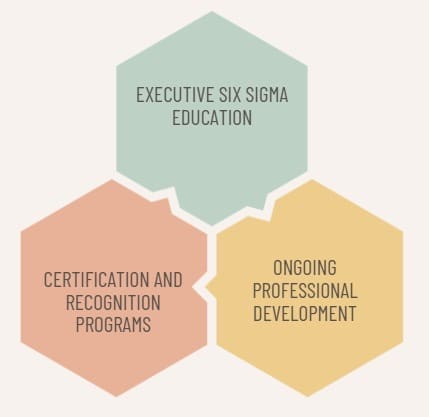A Champion in Six Sigma represents the highest level of executive leadership commitment to organizational transformation through data-driven process improvement. These senior leaders provide strategic direction, remove barriers, and ensure that Six Sigma initiatives align with business objectives while delivering measurable results.
Six Sigma Champions play crucial roles in driving cultural change, allocating resources, and maintaining momentum for continuous improvement programs. Furthermore, they serve as visible advocates who communicate the value of Six Sigma methodology throughout the organization and ensure sustained success.
Organizations with effective Six Sigma Champions consistently achieve breakthrough performance improvements, enhanced customer satisfaction, and significant cost savings across all business functions.
Table of contents
Champion Role in Six Sigma Hierarchy
The Champion in Six Sigma occupies the senior executive position within the Six Sigma organizational structure, typically reporting directly to the CEO or business unit president. This role provides strategic oversight and executive sponsorship for all Six Sigma activities within their area of responsibility.
Champions work closely with Master Black Belts, Black Belts, and Green Belts to ensure that improvement projects address critical business priorities and deliver substantial value. They also coordinate with other business functions to integrate Six Sigma methodology into daily operations and strategic planning processes.
The Champion role differs from other Six Sigma positions through its focus on strategic leadership rather than technical implementation. While Black Belts and Green Belts execute projects, Champions provide vision, resources, and organizational support necessary for program success.
Public, Onsite, Virtual, and Online Six Sigma Certification Training!
- We are accredited by the IASSC.
- Live Public Training at 52 Sites.
- Live Virtual Training.
- Onsite Training (at your organization).
- Interactive Online (self-paced) training,
Key Responsibilities of Six Sigma Champions

Strategic Leadership and Vision
Six Sigma Champions establish the strategic direction for process improvement initiatives while ensuring alignment with overall business objectives. They translate corporate goals into specific Six Sigma targets and communicate the importance of quality improvement throughout the organization.
These leaders develop comprehensive deployment strategies that prioritize high-impact improvement opportunities while building organizational capability. Additionally, they create compelling visions that motivate employees to embrace change and participate actively in improvement efforts.
Champions also establish governance structures that ensure consistent application of Six Sigma methodology across different departments and business units. This strategic oversight maintains program integrity while adapting approaches to meet specific organizational needs.
Resource Allocation and Support
Effective Champions allocate sufficient resources including personnel, training, technology, and financial support to ensure Six Sigma program success. They make difficult decisions about resource priorities while balancing immediate needs with long-term capability development.
These leaders remove organizational barriers that impede project progress, such as conflicting priorities, inadequate systems, or resistance to change. Furthermore, they provide political support that enables project teams to implement necessary changes despite internal opposition.
Champions also invest in infrastructure development including training programs, software tools, and measurement systems that support sustainable Six Sigma implementation. This foundational support ensures that improvement efforts can scale effectively across the organization.
Performance Monitoring and Accountability
Six Sigma Champions establish performance metrics and accountability structures that track program progress and ensure achievement of improvement targets. They review project results regularly and take corrective action when performance falls short of expectations.
These leaders conduct regular reviews with Master Black Belts and project teams to assess progress, resolve issues, and provide guidance. Additionally, they ensure that completed projects deliver promised benefits and that improvements are sustained over time.
Champions also integrate Six Sigma results into business performance reviews and executive reporting systems. This integration demonstrates program value while maintaining focus on continuous improvement throughout the organization.
Qualifications and Skills Required for Six Sigma Champions

Executive Leadership Experience
Six Sigma Champions must possess extensive executive leadership experience within their industry or functional area. This background provides the credibility and organizational influence necessary to drive significant change initiatives.
Successful Champions typically have profit-and-loss responsibility, strategic planning experience, and demonstrated ability to lead complex organizational transformations. Their leadership track record builds confidence among stakeholders and supports program adoption throughout the organization.
Additionally, Champions need deep understanding of business operations, market dynamics, and competitive challenges. This knowledge enables them to identify high-impact improvement opportunities and ensure that Six Sigma projects address critical business needs.
Business Acumen and Strategic Thinking
Effective Champions demonstrate strong business acumen and strategic thinking capabilities that enable them to connect process improvement activities with financial results. They understand how operational improvements translate into competitive advantages and shareholder value creation.
These leaders can analyze complex business situations, identify root causes of performance gaps, and develop comprehensive improvement strategies. Furthermore, they communicate business cases effectively to secure necessary resources and support from senior leadership.
Change Management and Communication Skills
Six Sigma Champions must excel at change management and communication to successfully transform organizational culture and behaviors. They understand how to build consensus, overcome resistance, and motivate employees to embrace new approaches.
These leaders communicate vision and strategy effectively across all organizational levels while adapting their messages to different audiences. Additionally, they create communication plans that maintain momentum and celebrate successes throughout the improvement journey.
Also Read: What is Risk Management Information System
Champion Training and Development Programs

Executive Six Sigma Education
Champion training programs provide executive-level education about Six Sigma methodology, tools, and implementation strategies. These programs focus on leadership aspects rather than technical details while ensuring sufficient understanding to provide effective oversight.
Training typically covers strategic deployment planning, project selection criteria, resource allocation decisions, and performance measurement approaches. Additionally, programs address change management techniques and communication strategies specific to Six Sigma implementations.
Ongoing Professional Development
Champion development continues beyond initial training through ongoing professional development activities including conferences, workshops, and peer networking opportunities. These activities help Champions stay current with evolving best practices and emerging trends.
Professional development programs also provide opportunities for Champions to share experiences, learn from peers, and develop innovative approaches to common challenges. This knowledge sharing accelerates organizational learning and improves program effectiveness.
Certification and Recognition Programs
Many organizations implement Champion certification programs that validate leadership competency and commitment to Six Sigma excellence. These programs establish standards for Champion performance while providing recognition for outstanding achievements.
Certification requirements typically include completion of training programs, demonstration of leadership effectiveness, and achievement of specified improvement results. Additionally, ongoing certification may require continuing education and sustained program performance.
Building Effective Champion Networks
Cross-Functional Collaboration
Six Sigma Champions must build effective networks that span organizational boundaries and facilitate cross-functional collaboration. These networks enable knowledge sharing, resource coordination, and alignment of improvement efforts across different business areas.
Champions participate in steering committees, governance boards, and leadership teams that coordinate Six Sigma activities at enterprise levels. Additionally, they establish regular communication channels that maintain alignment and prevent duplication of efforts.
External Partnerships and Benchmarking
Effective Champions develop external partnerships with other organizations, consultants, and professional associations to access best practices and emerging methodologies. These relationships provide valuable insights that enhance program effectiveness.
Benchmarking activities help Champions understand industry standards and identify opportunities for competitive advantage through superior process performance. Additionally, external partnerships provide access to specialized expertise and resources that may not be available internally.
Mentoring and Succession Planning
Six Sigma Champions play important roles in developing future leaders through mentoring and succession planning activities. They identify high-potential employees and provide development opportunities that build Champion capabilities.
Mentoring relationships enable knowledge transfer from experienced Champions to emerging leaders while ensuring program continuity. Additionally, these relationships help retain talented employees by providing clear career development paths.
Check Out this Podcast: The “One-Hit Wonder” Green Belts!
Champion Success Strategies and Best Practices
Setting Clear Expectations and Goals
Successful Champions establish clear expectations and measurable goals for Six Sigma programs while communicating these standards throughout the organization. They define success criteria, timelines, and accountability structures that guide improvement efforts.
Goal setting should align with business priorities while challenging the organization to achieve breakthrough performance improvements. Additionally, Champions must balance aggressive targets with realistic expectations based on organizational capability and resources.
Creating Supportive Infrastructure
Champions invest in infrastructure development that supports effective Six Sigma implementation including training programs, technology systems, and organizational structures. This infrastructure provides the foundation for sustainable improvement programs.
Training infrastructure ensures that employees develop necessary skills and knowledge to participate effectively in improvement efforts. Technology infrastructure provides tools and systems that enable efficient project management and data analysis.
Driving Cultural Transformation
Six Sigma Champions lead cultural transformation efforts that embed continuous improvement principles into organizational DNA. They model desired behaviors while creating incentives and accountability structures that reinforce cultural change.
Cultural transformation requires sustained effort and consistent messaging from leadership throughout the organization. Champions must demonstrate personal commitment to Six Sigma principles while recognizing and rewarding others who embrace these values.
Additionally, Champions address resistance to change through education, communication, and involvement strategies that help employees understand benefits and overcome concerns. This approach builds broad-based support for improvement initiatives.
Measuring Champion Effectiveness and Program Success
Financial Impact Metrics
Champion effectiveness is ultimately measured through financial impact metrics including cost savings, revenue improvements, and return on investment calculations. These metrics demonstrate program value while justifying continued investment in Six Sigma activities.
Cost savings typically result from process improvements that reduce waste, defects, and inefficiencies. Revenue improvements may come from enhanced customer satisfaction, faster cycle times, or improved product quality that increases market share.
Operational Performance Indicators
Operational performance indicators measure process improvements achieved through Six Sigma initiatives including quality metrics, cycle time reductions, and productivity enhancements. These indicators demonstrate tangible improvements in business performance.
Quality metrics such as defect rates, customer satisfaction scores, and first-pass yield provide evidence of process improvement effectiveness. Cycle time reductions demonstrate improved efficiency and responsiveness to customer needs.
Cultural and Organizational Development
Champion success also depends on cultural and organizational development indicators including employee engagement, skill development, and improvement culture maturity. These indicators measure progress toward sustainable transformation.
Employee engagement surveys assess workforce commitment to continuous improvement while identifying areas requiring additional attention. Training completion rates and certification achievements measure skill development progress.
Industry-Specific Champion Applications
Manufacturing Excellence
Manufacturing Champions focus on operational excellence through waste reduction, quality improvement, and productivity enhancement initiatives. They prioritize projects that address safety, cost, quality, and delivery performance.
Lean Six Sigma approaches combine waste elimination with variation reduction to achieve breakthrough manufacturing performance. Champions coordinate these efforts while ensuring alignment with production requirements and customer needs.
Service Industry Applications
Service industry Champions address unique challenges including process standardization, customer experience improvement, and service quality enhancement. They focus on projects that directly impact customer satisfaction and operational efficiency.
Service processes often involve high human interaction and variability that require specialized Six Sigma approaches. Champions ensure that improvement efforts address both process efficiency and service quality simultaneously.
Healthcare Process Improvement
Healthcare Champions focus on patient safety, clinical quality, and operational efficiency while navigating complex regulatory requirements and professional cultures. They prioritize projects that improve patient outcomes while reducing costs.
Healthcare Six Sigma initiatives often address medication errors, infection control, patient flow, and clinical process standardization. Champions ensure that improvement efforts maintain clinical quality while enhancing efficiency.
Future Trends in Champion Leadership
Digital Transformation Integration
Modern Champions increasingly integrate digital transformation initiatives with Six Sigma methodology to achieve breakthrough performance improvements. Digital technologies enable enhanced data collection, analysis, and process optimization capabilities.
Artificial intelligence and machine learning applications provide new opportunities for process improvement while requiring Champions to understand technology capabilities and limitations. This integration requires both technical knowledge and strategic vision.
Agile and Lean Integration
Contemporary Champions integrate Agile and Lean methodologies with Six Sigma to create comprehensive improvement approaches that address different organizational needs. This integration requires sophisticated understanding of multiple methodologies.
Agile approaches provide flexibility and responsiveness while Six Sigma ensures analytical rigor and sustainable improvements. Champions must balance these different approaches while maintaining program coherence.
Frequently Asked Questions on Champions in Six Sigma
What is a Champion in Six Sigma and what do they do?
A Champion in Six Sigma is a senior executive who provides strategic leadership, resources, and support for Six Sigma programs, ensuring alignment with business objectives while driving organizational transformation and measurable results.
What qualifications are required to become a Six Sigma Champion?
Six Sigma Champions typically need extensive executive leadership experience, strong business acumen, strategic thinking capabilities, change management skills, and demonstrated ability to lead complex organizational transformations.
How does a Champion differ from a Master Black Belt or Black Belt?
Champions provide strategic leadership and executive sponsorship while Master Black Belts and Black Belts focus on technical implementation and project execution, with Champions operating at the highest organizational levels.
What training do Six Sigma Champions receive?
Champion training focuses on executive-level education about Six Sigma methodology, strategic deployment, change management, and leadership skills rather than detailed technical tools and statistical analysis.
How do Champions measure the success of Six Sigma programs?
Champions measure success through financial impact metrics including cost savings and ROI, operational performance indicators like quality and cycle time improvements, and cultural development measures such as employee engagement.
What industries benefit most from Six Sigma Champion leadership?
All industries benefit from Champion leadership, but manufacturing, healthcare, financial services, and technology sectors particularly rely on Champions to drive process improvement and operational excellence initiatives.
How do Champions support organizational culture change?
Champions drive cultural transformation by modeling desired behaviors, creating supportive infrastructure, establishing accountability structures, and consistently communicating the value of continuous improvement throughout the organization.



















